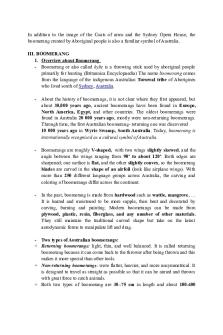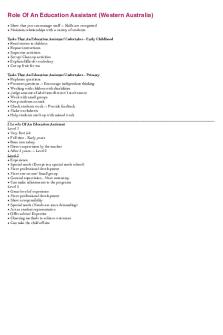Outline abut Boomerang - an interesting symbol of Australia PDF

| Title | Outline abut Boomerang - an interesting symbol of Australia |
|---|---|
| Author | Trang Lê |
| Course | Lịch sử văn minh |
| Institution | Đại học Hà Nội |
| Pages | 3 |
| File Size | 132.1 KB |
| File Type | |
| Total Downloads | 85 |
| Total Views | 187 |
Summary
A short outline about a symbol of Australia - Boomerang. It is a type of tool used mostly by Australian aboriginals and holds many traditional values....
Description
In addition to the image of the Coats of arms and the Sydney Opera House, the boomerang created by Aboriginal people is also a familiar symbol of Australia. III. BOOMERANG 1. Overview about Boomerang - Boomerang or also called kylie is a throwing stick used by aboriginal people primarily for hunting (Britannica Encyclopaedia) The name boomerang comes from the language of the indigenous Australian Turuwal tribe of Aborigines who lived south of Sydney, Australia. -
About the history of boomerangs, it is not clear where they first appeared, but about 30,000 years ago, ancient boomerangs have been found in Europe, North America, Egypt, and other countries. The oldest boomerangs were found in Australia 20 000 years ago, mostly were non-returning boomerangs. Through time, the first Australian boomerang- returning one was discovered 10 000 years ago in Wyrie Swamp, South Australia. Today, boomerang is internationally recognized as a cultural symbol of Australia.
-
Boomerangs are roughly V-shaped, with two wings slightly skewed, and the angle between the wings ranging from 90o to about 120o. Both edges are sharpened; one surface is flat, and the other slightly convex, so the boomerang blades are carved in the shape of an airfoil (look like airplane wings). With more than 250 different language groups across Australia, the carving and coloring of boomerangs differ across the continent.
-
In the past, boomerang is made from hardwood such as wattle, mangrove, … It is heated and moistened to be more supple, then bent and decorated by carving, burning and painting. Modern boomerangs can be made from plywood, plastic, resin, fiberglass, and any number of other materials. They still maintain the traditional curved shape but take on the latest aerodynamic forms to manipulate lift and drag.
- Two types of Australian boomerangs: + Returning boomerangs: light, thin, and well balanced. It is called returning boomerang because it can come back to the thrower after being thrown and this makes it more special than other tools. + Non-returning boomerangs: were flatter, heavier, and more unsymmetrical. It is designed to travel as straight as possible so that it can be aimed and thrown with great force to catch animals. + Both two types of boomerang are 30–75 cm in length and about 100-400
grams in weight.
+ How returning boomerang can turn back? When a boomerang is throwing, its two wings generate both spins (lực quay) and lift (lực nâng). This movement is created because of the characteristic V shape and its rounded edges. As it flies through the air, one wing travels faster than the other. The unbalanced force resulting from this difference causes the boomerang to turn in eclipse and come back to its starting point. For example, the right-hander will throw the Boomerang anti-clockwise and it will return to the left of the thrower and vice versa. - Facts: + Roughly 60% of Aboriginal people used both returning and non-returning boomerangs. + Not all Aboriginal people knew how to throw returning boomerangs. 2. Traditional and modern uses - Traditional uses: + Hunting: are perfect for hunting large upright animals such as kangaroos, emus and other marsupials. The hunter can throw the boomerang directly at the animal or make it ricochet off the ground. In skilled hands, the boomerang is effective for hunting prey up to 100 meters away. + Fighting weapons: grown at each other by combatants, medium-weight boomerangs are a deadly weapon, but for close-quarter skirmishing, large boomerangs up to two meters tall can be used as fighting sticks. + Digging stick when foraging for root vegetables or for scraping ashes away from a fire. They can also be used to make fire; the sharp edge of a boomerang when rubbed along a softwood surface creates enough heat to generate a spark that can ignite grass + Boomerangs feature prominently in Aboriginal dance and music, as a percussion instrument when a pair is rattled together, and as an accessory to ceremonial dance. -
Modern uses: Besides these traditional uses, boomerangs are used throughout the world for recreational and commercial purposes. + Boomerang competitions—measuring the speed and distance of thrown boomerangs as well as the accuracy and catching ability of the thrower—are held regularly throughout Europe, North America, Australia, and Japan. FESTIVAL: Boomerang Festival started in 2013, held at Byron Bay during Easter (4-6th October) annually. . https://www.creativespirits.info/aboriginalculture/arts/aboriginal-cultural-festivals
+ Boomerangs are one of the most popular tourist-trade items in Australia. The symbol has been used by airlines, taxi companies and travel agents to suggest they will return their clients safely home. The tourism industry chooses boomerangs as the iconic image of souvenirs that embody the sentiment of “Please return someday” when saying goodbye to visitors and friends. + Where to see and buy: in every tacky souvenir shop around tourist precincts like Circular Quay in Sydney and Flinders St Station in Melbourne, but if you’re interested in discovering authentic Aboriginal boomerangs, head somewhere like the Bunjilaka Aboriginal Cultural Centre in Melbourne or the Yiribana Aboriginal and Torres Strait Art Gallery in the Art Gallery of NSW. ● When purchasing a boomerang with Aboriginal designs, it is important to consider buying only from reputable Aboriginal craftsmen or approved outlets and to respect the cultural origins of this remarkable artifact 3. Symbolic values - The Australian Aborigines are one of the few cultures in history never to develop a bow and arrow, they depend on boomerangs to hunt animals for food. The Australian Aborigines are one of the few cultures in history never to develop a bow and arrow, they depend on boomerangs to hunt animals for food. The boomerang (both hunting and returning) was preserved in its highest state of development by the Australian Aborigines. => For aboriginal people, the boomerang is a symbol of cultural endurance and a tangible link to their long presence on this continent. - Boomerangs are also works of art, and Aboriginals often paint or carve designs on them related to legends and traditions - Boomerangs play a key role in aboriginal mythology, known as The Dreaming — mythical characters are said to have shaped the hills and valleys and rivers of their landscape by throwing the boomerangs around in the hunt. Summary: Through this all, boomerangs have endured. Boomerang is really a tangible link to Aboriginal history and an internationally recognized symbol of Australia....
Similar Free PDFs

Chaitya Hall Symbol of Balance
- 1 Pages

Culture of Australia
- 9 Pages

Decline IN THE RAND - Interesting
- 23 Pages

Australia
- 4 Pages

Writing-an-outline - Lol
- 2 Pages

02.06 Creating An Outline
- 4 Pages

Hazard symbol
- 24 Pages

Religious Symbol
- 5 Pages

Zusammenfassung se6 Symbol
- 1 Pages
Popular Institutions
- Tinajero National High School - Annex
- Politeknik Caltex Riau
- Yokohama City University
- SGT University
- University of Al-Qadisiyah
- Divine Word College of Vigan
- Techniek College Rotterdam
- Universidade de Santiago
- Universiti Teknologi MARA Cawangan Johor Kampus Pasir Gudang
- Poltekkes Kemenkes Yogyakarta
- Baguio City National High School
- Colegio san marcos
- preparatoria uno
- Centro de Bachillerato Tecnológico Industrial y de Servicios No. 107
- Dalian Maritime University
- Quang Trung Secondary School
- Colegio Tecnológico en Informática
- Corporación Regional de Educación Superior
- Grupo CEDVA
- Dar Al Uloom University
- Centro de Estudios Preuniversitarios de la Universidad Nacional de Ingeniería
- 上智大学
- Aakash International School, Nuna Majara
- San Felipe Neri Catholic School
- Kang Chiao International School - New Taipei City
- Misamis Occidental National High School
- Institución Educativa Escuela Normal Juan Ladrilleros
- Kolehiyo ng Pantukan
- Batanes State College
- Instituto Continental
- Sekolah Menengah Kejuruan Kesehatan Kaltara (Tarakan)
- Colegio de La Inmaculada Concepcion - Cebu






